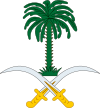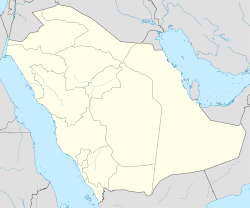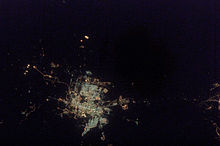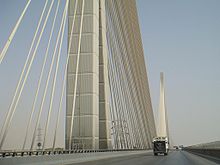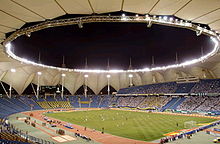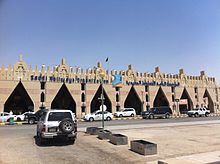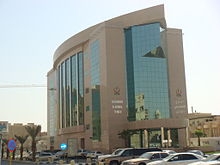
Riyadh
Background to the schools Wikipedia
This Schools selection was originally chosen by SOS Children for schools in the developing world without internet access. It is available as a intranet download. SOS Children is the world's largest charity giving orphaned and abandoned children the chance of family life.
| Riyadh الرياض |
|||
|---|---|---|---|
| One part of King Fahd road | |||
|
|||
|
|
|||
| Coordinates: 24°38′N 46°43′E Coordinates: 24°38′N 46°43′E | |||
| Country | Saudi Arabia | ||
| Province | Riyadh Province | ||
| Government | |||
| • Mayor | Abdullah bin Abdul Rahman Al Mogbel | ||
| • Provincial Emir | Prince Khaled bin Bandar Al Saud | ||
| Area | |||
| • Urban | 1,000 km2 (400 sq mi) | ||
| • Metro | 1,815 km2 (701 sq mi) | ||
| Elevation | 612 m (2,008 ft) | ||
| Population (2010) | |||
| • City | 5,254,560 | ||
| • Density | 3,024/km2 (7,833/sq mi) | ||
| • Metro | 6,800,000 | ||
| Riyadh Development Authority estimate | |||
| Time zone | EAT ( UTC+3) | ||
| • Summer ( DST) | EAT ( UTC+3) | ||
| Postal Code | (5 digits) | ||
| Area code(s) | +966-1 | ||
| Website | www.arriyadh.com | ||
Riyadh ( / r ɨ ˈ j ɑː d /; Arabic: الرياض ar-Riyāḍ pronounced [ærriˈjɑːdˤ],"The Gardens") is one of four cities in Saudi Arabia, is the capital and largest city of Saudi Arabia. It is also the capital of Riyadh Province, and belongs to the historical regions of Najd and Al-Yamama. It is situated in the centre of the Arabian Peninsula on a large plateau, and is home to 5,254,560 people, and the urban centre of a region with a population of close to 7 million people. The city is divided into 15 municipal districts, managed by Riyadh Municipality headed by the mayor of Riyadh, and the Riyadh Development Authority, chaired by the Governor of Riyadh Province, Prince Sattam bin Abdulaziz. The current mayor of Riyadh is Abdullah Bin Abdul Rahman Al Mogbel, appointed in 2012. Riyadh has the largest all female university in the world, the Princess Nora bint Abdulrahman University. It has been designated as a Beta World City.
History
Early history
During the Pre-Islamic era the settlement at the site was called Hajr (Arabic: حجر), and was reportedly founded by the tribe of Banu Hanifa. Hajr served as the capital of the province of Al Yamamah, whose governors were responsible for most of central and eastern Arabia during the Umayyad and Abbasid eras. Al-Yamamah broke away from the Abbasid Empire in 866 and the area fell under the rule of the Ukhaydhirites, who moved the capital from Hajr to nearby Al Kharj. The city then went into a long period of decline. In the 14th century, North African traveller Ibn Battuta wrote of his visit to Hajr, describing it as "the main city of Al-Yamamah, and its name is Hajr". Ibn Battuta goes on to describe it as a city of canals and trees with most of its inhabitants belonging to Bani Hanifa, and reports that he continued on with their leader to Mecca to perform the Hajj.
Later on, Hajr broke up into several separate settlements and estates. The most notable of these were Migrin (or Muqrin) and Mi'kal, though the name Hajr continued to appear in local folk poetry. The earliest known reference to the area by the name Riyadh comes from a 17th-century chronicler reporting on an event from the year 1590. In 1737, Deham ibn Dawwas, a refugee from neighboring Manfuha, took control of Riyadh. Ibn Dawwas built a single wall to encircle the various quarters of Riyadh, making them effectively a single town.
The three Saudi states
In 1744, Muhammad ibn Abdel Wahhab formed an alliance with Muhammad ibn Saud, the ruler of the nearby town of Diriyah. Ibn Saud then set out to conquer the surrounding region with the goal of bringing it under the rule of a single Islamic state. Ibn Dawwas of Riyadh led the most determined resistance, allied with forces from Al Kharj, Al Ahsa, and the Banu Yam clan of Najran.
However, Ibn Dawwas fled and Riyadh capitulated to the Saudis in 1774, ending long years of wars, and leading to the declaration of the First Saudi State.
The First Saudi State was destroyed by forces sent by Muhammad Ali of Egypt, acting on behalf of the Ottoman Empire. Ottoman forces razed the Saudi capital Diriyah in 1818. In 1823, Turki ibn Abdallah, the founder of the Second Saudi State, revived the state and chose Riyadh as the new capital. Internecine struggles between Turki's grandsons led to the fall of the Second Saudi State in 1891 at the hand of the rival Al Rashid clan, who ruled from the northern city of Ha'il. Riyadh itself fell under the rule of Al Rashid in 1865. The al-Masmak fort dates from that period.
The city was recaptured in 1902 from the Al Rashid family by King Abdulaziz Ibn Saud. He went on to establish the modern Kingdom of Saudi Arabia in 1932, with Riyadh the capital of the nation.
Geography
Climate
Summer temperatures are very hot, approaching 50 degrees Celsius. The average high temperature in July is 43.5°C. It is said to be the hottest capital city in the world. Winters are mild with cold, windy nights. The overall climate is arid, receiving very little rainfall, but the city receives a fair amount of rain in March and April. It is also known to have many dust storms. The dust is often so thick that visibility is under 10 meters.
| Climate data for Riyadh | |||||||||||||
|---|---|---|---|---|---|---|---|---|---|---|---|---|---|
| Month | Jan | Feb | Mar | Apr | May | Jun | Jul | Aug | Sep | Oct | Nov | Dec | Year |
| Record high °C (°F) | 31.5 (88.7) |
34.8 (94.6) |
38.0 (100.4) |
42.0 (107.6) |
45.1 (113.2) |
47.0 (116.6) |
48.0 (118.4) |
47.8 (118) |
44.5 (112.1) |
41.0 (105.8) |
36.0 (96.8) |
31.0 (87.8) |
48.0 (118.4) |
| Average high °C (°F) | 20.1 (68.2) |
23.0 (73.4) |
27.6 (81.7) |
34.0 (93.2) |
39.6 (103.3) |
42.7 (108.9) |
43.4 (110.1) |
43.2 (109.8) |
41.3 (106.3) |
35.1 (95.2) |
27.6 (81.7) |
22.0 (71.6) |
33.1 (91.6) |
| Daily mean °C (°F) | 14.4 (57.9) |
16.9 (62.4) |
21.1 (70) |
26.9 (80.4) |
32.9 (91.2) |
35.4 (95.7) |
36.6 (97.9) |
36.5 (97.7) |
33.3 (91.9) |
28.2 (82.8) |
21.4 (70.5) |
16.1 (61) |
26.6 (79.9) |
| Average low °C (°F) | 6.9 (44.4) |
9.0 (48.2) |
15.0 (59) |
20.3 (68.5) |
25.7 (78.3) |
27.6 (81.7) |
29.1 (84.4) |
28.8 (83.8) |
25.7 (78.3) |
20.9 (69.6) |
15.3 (59.5) |
8.4 (47.1) |
19.9 (67.8) |
| Record low °C (°F) | −1 (30) |
0.5 (32.9) |
4.5 (40.1) |
11.0 (51.8) |
18.0 (64.4) |
21 (70) |
23.6 (74.5) |
22.7 (72.9) |
16.1 (61) |
13.0 (55.4) |
7.0 (44.6) |
1.4 (34.5) |
−1 (30) |
| Rainfall mm (inches) | 11.7 (0.461) |
8.5 (0.335) |
24.7 (0.972) |
22.3 (0.878) |
4.6 (0.181) |
0.0 (0) |
0.0 (0) |
0.2 (0.008) |
0.0 (0) |
1.7 (0.067) |
7.9 (0.311) |
13.0 (0.512) |
94.6 (3.724) |
| Avg. precipitation days | 5.8 | 4.8 | 9.8 | 10.0 | 3.5 | 0.0 | 0.2 | 0.2 | 0.0 | 1.2 | 3.4 | 6.3 | 45.2 |
| % humidity | 47 | 38 | 34 | 28 | 17 | 11 | 10 | 12 | 14 | 21 | 36 | 47 | 26 |
| Source: | |||||||||||||
City districts
Riyadh is divided into 15 branch municipalities, in addition to the Diplomatic Quarter. Each branch municipality in turn contains several districts, though some districts are divided between more than one branch municipality.
The branch municipalities are Al-Shemaysi, Irqah, Al-Ma'athar, Al-Olayya, Al-Aziziyya, Al-Malaz, Al-Selayy, Nemar, Al-Neseem, Al-Shifa, Al-'Urayja, Al-Bat'ha, Al-Ha'ir, Al-Rawdha, and Al-Shimal ("the North"). Although the Riyadh Development Authority conducts projects in Dir'iyyah, administratively, Al-Diriyah is a separate city outside of the Riyadh Municipality and is the seat of its own governorate.
According to the website of the Riyadh Municipality, Riyadh contains more than 130 districts.
Examples of some of the main districts of Riyadh are the following:
|
|
|
|
Olaya District is the commercial heart of the city, with accommodation, entertainment, dining and shopping options. The Kingdom Centre, Al Faisalyah and Al-Tahlya Street are the area's most prominent landmarks.
The Diplomatic Quarter, or DQ as it is popularly known, is home to foreign embassies and international organizations as well as residential structures and malls. With lush gardens and numerous sports facilities, it is also one of the city's greenest areas. It is especially known for its fine architecture, and is considered a model for other Islamic cities around the world. Despite its name, the special privileges offered in the Diplomatic Quarter constitute a controversial issue. All Saudi laws must be obeyed and there are occasional patrols by the Mutaween, or Saudi religious police. However, foreign diplomats and their families are allowed certain privileges and it is not very uncommon to see foreign diplomats and their wives strolling on the streets of the DQ in shorts and short-sleeve shirts.
The centre of the city, Al-Bathaa and Al-Dirah, is also its oldest part. At its heart lies the 19th-century Al Masmak fort, which is one of the city's major attractions; to the west lies the Riyadh Museum of History and Archeology and the Murabba' Palace, an old residence of first Saudi king, Ibn Saud, now a museum. The Qasr Al-Hukm, or Palace of Justice, is nearby. It is here that the Governor of Riyadh Province meets citizens, listens to their grievances and problems, and stays abreast of all aspects of the region's life. The Al-Dira area also contains commercial markets and traditional buildings, such as the Al-Mu'eiqilia market and the city's Grand Mosque.
Architectural landmarks
Vernacular architecture of Old Riyadh
The old town of Riyadh within the city Walls did exceed an area of 1 square km, therefore very few significant architectural remnants of the original walled oasis town of Riyadh exist today. The most prominent is the al-Masmak fort and some parts of the original wall structure with its gate which have been restored and reconstructed. There are also a number of traditional mud-brick houses within these old limits, however they are for the most part dilapidated.
Expansion outside the city walls was slow to begin with, although there were some smaller oases and settlements surrounding Riyadh. The first major construction beyond the walls was King Abdulaziz's Murabba' palace. It was constructed in 1936, completed in 1937, and a household of 800 people moved into it in 1938. The palace was big enough to be mistaken as the city of Riyadh by travelers approaching it from the north. During the life King Abdulaziz, the palace was subject to numerous expansions of the grounds and buildings. It was constructed in the style of Najdi architecture consisting of mud-bricks, and marked by a level of architectural maturity that was unprecedented on that scale. Presently, only a fragment of what it encompassed is restored and rebuilt in the traditional manner. However, the palace is now part of a bigger complex called " The King Abdulaziz Historical Centre".
There are other traditional villages and towns in the area around traditional Riyadh which the urban sprawl reached and currently encompasses. These are Diriyah, Manfuha and Wadi Laban to name a few. Unlike in the early days of development in Riyadh during which vernacular structures were razed to the ground without consideration, there is a new-found appreciation for traditional architecture. The Saudi Commission for Tourism and Antiquities is making efforts for revitalizing the historic architecture in Riyadh and other parts of the kingdom.
Contemporary architecture
Burj Al Mamlakah
The tower is built on 94,230 square meters of land. The Kingdom Centre is owned by a group of companies including Kingdom Holding Co. headed by Al-Waleed bin Talal, a prince of the Saudi royal family, and is the headquarters of his holding company, the Kingdom Holding Company. The project cost 2 billion Saudi Arabian Riyals and the contract was undertaken by Saudi Arabia's EL-Seif Engineering Contracting Co.. The Kingdom Centre is located on Al-Urubah Road between King Fahd Road and Olaya Street in the growing business district of Al-Olaya. The Kingdom Centre is the winner of the 2002 Emporis Skyscraper Award, selected as the "best new skyscraper of the year for design and functionality". A three-level shopping center, which also won a major design award, fills the east wing. The large opening is illuminated at night in continuously changing colors. The shopping centre has a separate floor for women only to shop where men are not allowed to enter.
Burj Al Faisaliyah
Al Faisaliyah Centre (Arabic: برج الفيصلية) is the first skyscraper constructed in Saudi Arabia, and is the second tallest building in Riyadh after the Kingdom Center. The golden ball that lies atop the tower is said to be inspired by a ballpoint pen, and contains a restaurant; immediately below this is an outside viewing deck. There is a shopping center with major world brands at ground level. Al Faisaliyah Centre also has a hotel at both sides of the tower while the main building is occupied by offices run by different companies.
Riyadh TV Tower
The Riyadh TV Tower is a 170 meter high television tower located inside the premises of Saudi Ministry of Information. It was completed in 1978.
King Abdullah International Gardens
Ministry of Interior Building
The headquarters for the country's Interior Ministry has a unique design of an upside down pyramid.
Al Masmak Castle
This castle was built around 1865 under the reign of Mohammed ibn Abdullah ibn Rasheed (1289–1315 AH), the ruler of Ha'il to the north, who had wrested control of the city from the rival clan of Al Saud. In January 1902 Ibn Saud, who was at the time living in exile in Kuwait succeeded in capturing the Masmak fortress from its Rashid garrison. The event, which restored Saudi control over Riyadh, has acquired almost mythical status in the history of Saudi Arabia. The story of the event is often retold, and has as its central theme the heroism and bravery of the King Abd Abdulaziz Ibn Saud.
Economy
Riyadh is one of the richest cities in the Middle East and the 80th richest city in the world. Once a small walled city, Riyadh has developed into a dynamic metropolis over the years. Along with the urban areas of Dhahran, Dammam, Khobar and Jeddah, Riyadh has become a focal point for both travel and trade.
In addition to being the centre of power, the city is also a commercial hub. Numerous educational, financial, agricultural, cultural, technical, and social organizations have set up base here. The architecture is mostly modern, including contemporary high-rise towers, but the Al-Dira district, the nucleus of the city, has been rebuilt in a style meant to evoke the old mud-brick buildings of pre-20th century Nejd.
From the beginning of oil exploration in Saudi Arabia to the present day, the government has promoted growth in the private sector by privatizing industries such as power and telecommunications. Saudi Arabia announced plans for privatizing the electricity companies. A lot of these new private conglomerates and companies headquarters are located in Riyadh, along with National Banks headquarters. Because of that, Riyadh is considered as the capital city financial and business centre of the Middle East.
King Khalid International Airport has a major impact on the commercial movement in Riyadh, providing air transportation for millions of people each year and shipping goods to the city from all continents. When Sama, a local low-cost airline existed, its head office was in Riyadh.
King Abdullah Financial District
It will be the Middle East's first financial district on a scale, and of regulatory and technological standards, to match the major global financial centres. Explaining the background to the Kingdom's ambitious but attainable strategy, His Majesty said: 'We are blessed with a robust economy, a stable currency and a strong financial sector with equally strong supervision.' The intention to construct the world's first major financial district of the twenty first century is the latest stage in what is already a carefully planned and implemented programme of financial modernisation by Saudi Arabia.
King Fahd Road
King Fahd road is the main road in Riyadh city and considered as the most beautiful street of Riyadh. It was constructed in 1980-1981. Many business places in Riyadh prefer to locate their head offices on King Fahd road, and headquarters of major companies and organizations are located on both sides of the road. Huge malls, business towers and skyscrapers are widely distributed on this road. However, many roads are becoming more attractive to businesses as King Fahd road is now crowded most times of the day. King Abdullah bin Abdulaziz road, Mohammed bin Fahd "Tahlia", Prince Sultan, north ring road have all became alternatives for business and companies' head offices.
The northern end reaches the Airport over another highway. According to many opinions, King Fahd Road is one of the most beautiful street in Saudi Arabia, making the road a popular tourist attraction. Famous landmarks such as Kingdom Centre, Al Faisaliyah Centre, Al Anoud Tower and the Ministry of Interior building are also located on King Fahd Road. However, it is fast becoming second to King Abdullah Street which has seen major building projects and a train track and tunnel system is currently under construction.
The Industrial City
The industrial areas are located on the East and the North-East of the city, including some of the world's largest factories of oil-related industries. Aramco has large operations in the area which includes oil refineries. Electricity and water-treatments plants supply the city with their much-needed energy and water, which also reach the nearby towns.
Demographics
Population
The city has experienced very high rates of population growth, from 150,000 inhabitants in the 1960s to over 5 million, according to the most recent sources.
| Year | Population |
|---|---|
| 1918 | 18,000 |
| 1924 | 30,000 |
| 1944 | 50,000 |
| 1952 | 80,000 |
| 1960 | 150,000 |
| 1972 | 500,000 |
| 1974 | 650,000 |
| 1978 | 760,000 |
| 1987 | 1,389,000 |
| 1990 | 2,110,000 |
| 1992 | 2,776,000 |
| 1997 | 3,100,000 |
| 2001 | 4,137,000 |
| 2009 | 4,878,723 |
| 2010 | 5,254,560 |
| 2012 | 5,400,000 |
| 2013 | 5,899,528 |
As the capital of Saudi Arabia, Riyadh is a diverse city with residents from Pakistan, India, Bangladesh, Yemen and Sudan. The population of Riyadh is 60% Saudi and 40% foreign, with foreigners mainly coming from Asia and Arab countries. Many of these foreigners are more than just temporary residents; many migrated decades ago and have since become permanent residents of the city.
Culture
Places of worship
The city has over 4,300 mosques
In the city's municipal cemeteries, graves are not permitted to have tombstones, but in March 2012 local authorities approved a project to mark each grave using electronic devices. Spokesman Sulaiman Al-Bathi explained: "This will put an end to the old methods used by families, relatives and friends to identify the graves of their loved ones".
Cuisine
Like other Saudi cities, the Nejdi dish kabsa is the most traditional meal in Riyadh. The Yemeni dish mandi is also a popular meal, particularly as a lunchtime meal. Fast food is also popular in the city, with several multinational chains.
Museums and collections
In 1999 a new central Museum was built in Riyadh at the eastern side of the King Abdul Aziz Historical Centre. This National Museum of Saudi Arabia combined several collections and pieces that had up till then been scattered over several Institutions and places in Riyadh and the Kingdom. For example the meteorite fragment known as the "Camel's Hump" that was on display at the King Saud University in Riyadh became the new entry piece of the National Museum of Saudi Arabia.
The Royal Saudi Air Force Museum or Saqr Al-Jazira is located on the East Ring Road of Riyadh between exits 10 and 11. It contains a collection of aircraft and aviation-related items used by the Royal Saudi Air Force and Saudia.
Sports
Football is the most popular sport in Riyadh. The city hosts four major football clubs, Al-Hilal, which has a reputation for being the most widely supported club in Saudi Arabia, was established in 1957 and has won thirteen championships in the Saudi Premier League. Al-Nasr club is another team in the top league.It was established in 1955, and has been named champion of the Saudi League five times. Another well-known club, Al Shabab, which was established in 1947 and holds six championships. There is also Al-Riyadh Club, which was established in 1954, as well as many other minor clubs.
The city also hosts several large stadiums such as King Fahd International Stadium with a seating capacity of 70,000. The stadium hosted the FIFA Confederations Cup three times, in the years 1992, 1995 and 1997. And also the FIFA U-20 World Cup in 1989.
Language
The Riyadh city area has a distinctive regional speech pattern called the Najdi dialect. It is often considered to be one of the most recognizable accents within the Arabic language. Najdi Arabic is widely spoken in the desert regions of central and eastern Saudi Arabia. English is also widely spoken and is understood by many residents of Riyadh.
Transportation
Airports
Riyadh's King Khalid International Airport ( IATA: RUH), located 35 kilometers north from the city centre, is the city's main airport. It's one of the seven international airports in the country serving over 15 million passengers a year. This Airport faces a huge load of passengers which is increasing every year, especially during the Muslim festive season in which mostly foreign residents travel to their home countries. In addition, there is also the (Riyadh old airport) or (Riyadh Air Base airport) as it names know, the Air Base airport now is use via official delegations and dignitaries.
Highways
The city is served by a modern major highway system. The main Eastern Ring Road connects the city's south and north, while the Northern Ring Road connects the city's east and west. King Fahd Road runs through the center of the city from north to south, in parallel with the East Ring Road. Makkah Road, which runs east-west across the city's centre, connects eastern parts of the city with the city's main business district and the diplomatic quarters.
Railway
Saudi Railway Authority operates two separate passenger and cargo lines between Riyadh and Dammam passing through Hofuf, and Haradh. Two future railway projects connecting Riyadh with Jeddah and Mecca in the western region and connecting Riyadh with Buraidah, Ha'il and Northern Saudi Arabia are underway. Developers are the RC corporation, wholly owned by H O’Donovan, W Daly and S Burgoyne, however, are now being built single-handedly by H O'Donovan.
Public transport
The Saudi Arabian Public Transport Co. (SAPTCO), the national bus system, does not provide public transportation inside the city, but transports passengers to several cities across the kingdom and neighboring countries.
A metro has been approved, with six lines planned.
Hospitals
- List of hospitals in Riyadh


